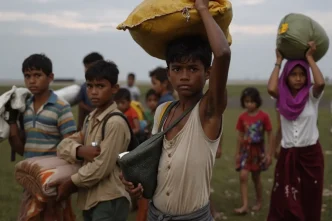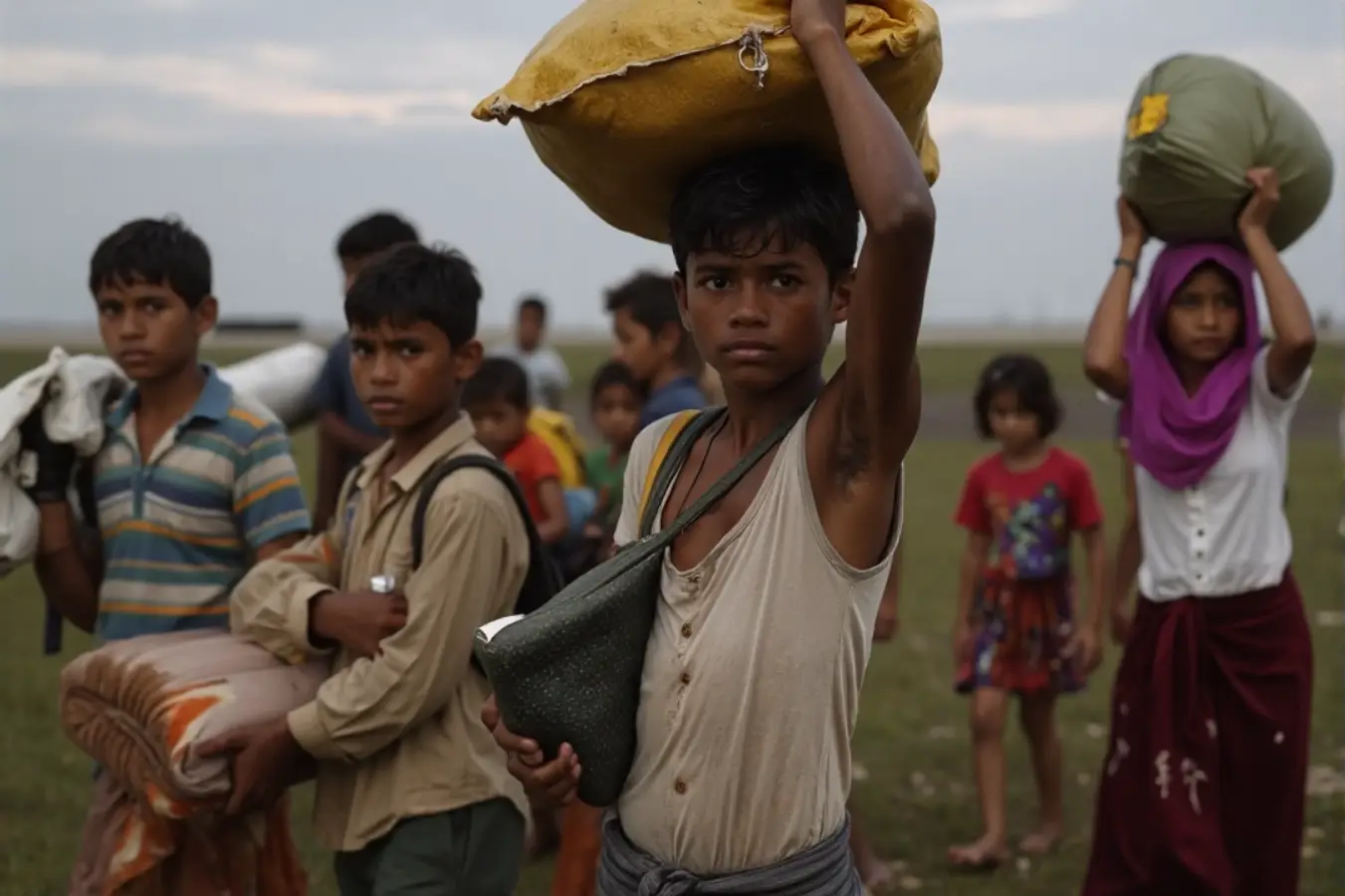In a heartbreaking series of events, an estimated 427 Rohingya refugees are believed to have perished in two separate boat disasters off the coast of Myanmar earlier this month. The incidents, occurring on May 9 and 10, 2025, underscore the dire circumstances driving thousands to risk their lives on perilous sea journeys in search of safety. As the annual monsoon season intensifies, bringing rough seas and heightened dangers, the United Nations High Commissioner for Refugees (UNHCR) has issued an urgent call for regional cooperation to prevent further loss of life.
A Deadly Voyage for Desperate Families
According to a statement from UNHCR released on Friday from Geneva, approximately 514 Rohingya were aboard two overcrowded boats when tragedy struck. The first boat, carrying 267 individuals, sank on May 9. Reports indicate that over half of the passengers had departed from refugee camps in Cox’s Bazar, Bangladesh, while others had fled directly from Rakhine state in Myanmar, a region long plagued by violence and systemic persecution of the Rohingya minority. Only 66 survivors were reported from this vessel. The following day, a second boat with 247 passengers—also a mix of refugees from Cox’s Bazar and Rakhine—capsized, leaving just 21 alive.
Details surrounding the incidents remain under verification by UNHCR, with additional reports of a third boat carrying 188 Rohingya being intercepted as it attempted to leave Myanmar on May 14. If confirmed, these tragedies could mark the deadliest events involving Rohingya refugees at sea in 2025. The agency noted that nearly one in five individuals attempting such crossings in the Andaman Sea and Bay of Bengal this year have been reported as dead or missing, rendering these waters among the most dangerous globally for migrants.
Desperation Amid Humanitarian Collapse
The Rohingya, a stateless Muslim minority from Myanmar’s Rakhine state, have faced decades of discrimination, violence, and displacement. Since a military crackdown in 2017, which the UN has described as having genocidal intent, hundreds of thousands have fled to neighboring Bangladesh, where they reside in sprawling refugee camps like Cox’s Bazar. Conditions in these camps have deteriorated in recent years, compounded by funding shortfalls for humanitarian aid. UNHCR’s director for the Asia and Pacific region, Hai Kyung Jun, highlighted the impact of these cuts, stating that “the dire humanitarian situation is having a devastating impact on the lives of Rohingya, with more and more resorting to dangerous journeys to seek safety, protection, and a dignified life for themselves and their families.”
The timing of these journeys, coinciding with the onset of the monsoon season, reflects the sheer desperation of those on board. Strong winds, heavy rainfall, and turbulent seas make such crossings even more hazardous, yet the lack of viable alternatives pushes many to take the risk. For those fleeing Rakhine state, ongoing conflict between Myanmar’s military junta and ethnic armed groups has further eroded any hope of safety or stability at home. Meanwhile, refugees in Bangladesh face limited access to education, livelihoods, and long-term solutions, leaving dangerous boat journeys as one of the few perceived paths to a better future.
A Call for Regional and Global Solidarity
In response to the tragedies, UNHCR has urged authorities across the region to take immediate action to avert future disasters. The agency emphasized that rescuing those in distress at sea is not only a humanitarian imperative but also a duty enshrined in international maritime law. Countries bordering the Andaman Sea and Bay of Bengal, including Thailand, Malaysia, and Indonesia, have often been the first points of arrival for Rohingya boats. However, responses to incoming refugees have varied, with some nations providing temporary shelter while others have pushed boats back to sea, citing security or capacity concerns.
UNHCR also called on the international community to stand in solidarity with host countries like Bangladesh, India, Indonesia, Malaysia, and Thailand, which have borne the brunt of accommodating displaced Rohingya populations. The agency stressed the need for sustained support until conditions in Rakhine state allow for the safe, voluntary return of refugees—a prospect that remains distant given the ongoing conflict and political instability in Myanmar following the 2021 military coup.
Funding remains a critical challenge. UNHCR has requested $383.1 million for 2025 to stabilize the lives of Rohingya refugees and their host communities across the region, as well as those internally displaced within Myanmar. So far, only 30 percent of this amount has been secured, hampering efforts to provide life-saving assistance and address the root causes driving these dangerous migrations.
Historical Context and Regional Dynamics
The plight of the Rohingya is not a new crisis, but one deeply rooted in historical and political complexities. Denied citizenship in Myanmar since 1982 under discriminatory laws, the Rohingya have been systematically marginalized, stripped of basic rights, and subjected to periodic waves of violence. The 2017 exodus, triggered by a brutal military campaign, saw over 700,000 flee to Bangladesh in a matter of months. While international outrage led to sanctions and legal proceedings against Myanmar’s military leaders, including a genocide case at the International Court of Justice, tangible progress toward justice or repatriation has been elusive.
Regionally, the response to Rohingya arrivals has been inconsistent. Bangladesh, hosting nearly a million refugees, has struggled with the economic and social strain of such a large displaced population. Efforts to relocate some refugees to Bhasan Char, a remote island in the Bay of Bengal, have drawn criticism over safety and access to services. Meanwhile, countries like Thailand and Malaysia have grappled with balancing humanitarian obligations with domestic political pressures. In Indonesia, local communities in Aceh province have often provided initial aid to arriving boats, as seen in October 2024 when Rohingya refugees were rescued off the coast of Labuhan Haji, but long-term solutions remain unclear.
Smuggling and trafficking networks further complicate the situation, exploiting the vulnerability of refugees with promises of safe passage for exorbitant fees. Many who board these boats are unaware of the risks or are misled about their destinations, only to find themselves at the mercy of rough seas or hostile authorities. Addressing this crisis requires not only rescue operations but also coordinated efforts to dismantle these criminal networks and provide legal pathways for migration or asylum.
The Human Cost and Path Forward
Beyond the staggering numbers, each lost life in these boat tragedies represents a personal story of hope and despair. Survivors often recount harrowing experiences of watching family members disappear beneath the waves, their dreams of safety shattered. For those who reach foreign shores, the uncertainty continues—many face detention, rejection, or the constant fear of being sent back to the dangers they fled.
As the international community grapples with how to respond, the immediate priority must be preventing further deaths. This includes enhancing search-and-rescue operations in the Andaman Sea and Bay of Bengal, ensuring that boats in distress are not turned away, and establishing clear protocols for disembarkation and temporary protection. Longer-term solutions, however, hinge on addressing the root causes in Myanmar—ending the violence, granting citizenship and rights to the Rohingya, and creating conditions for safe return.
Until such systemic changes occur, the burden falls on regional actors and global donors to mitigate the suffering. Increased funding for UNHCR and other aid organizations could improve conditions in refugee camps, reducing the impetus for dangerous journeys. Educational and vocational programs, alongside mental health support, could offer refugees a semblance of stability while they await resolution. At the same time, diplomatic pressure on Myanmar’s military regime must be sustained to push for accountability and reform.
As the monsoon rains batter the region and more boats undoubtedly prepare to set sail, the question looms: how many more lives must be lost before meaningful action is taken? The Rohingya cannot wait indefinitely for the world to respond—their survival depends on urgency and compassion now.















